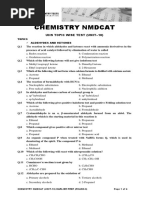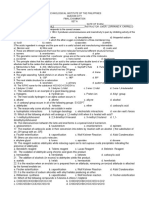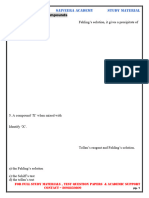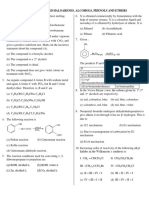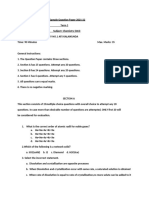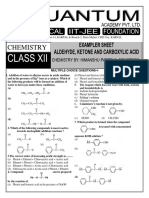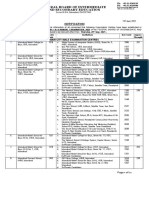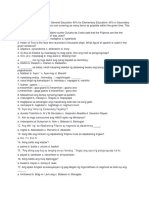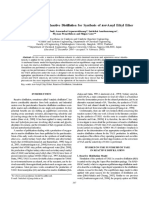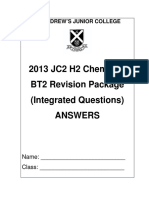12 - TPP - Aliphatic Hydrocarbons
12 - TPP - Aliphatic Hydrocarbons
Uploaded by
Saadia AsgharCopyright:
Available Formats
12 - TPP - Aliphatic Hydrocarbons
12 - TPP - Aliphatic Hydrocarbons
Uploaded by
Saadia AsgharCopyright
Available Formats
Share this document
Did you find this document useful?
Is this content inappropriate?
Copyright:
Available Formats
12 - TPP - Aliphatic Hydrocarbons
12 - TPP - Aliphatic Hydrocarbons
Uploaded by
Saadia AsgharCopyright:
Available Formats
MathsflixByHashimZia PhysicsKaManjan ChemistryBySaadWaqar
CHEMISTRY ALIPHATIC HYDROCARBONS – PRACTICE PROBLEMS
1. In the combustion reaction of alkanes if Ethane 6. Incomplete oxidation of methane in the limited
is used how many moles of oxygen are supply of air forms
required?
a. CO2 and H2O
a. 3 b. CH3OH
b. 4 c. CO + H2 + C
c. 7 d. CO + H2O + C
d. 3.5
Explanation 7. Up to how many carbons alkane are gases?
The combustion reaction of alkanes has a standard
reaction that is a. 3
CnH2n+2 + (3n/2 + 1/2) O2 → nCO2 + (n + 1) H2O. In the b. 4
case of combustion of ethane, n = 2. That means the c. 5
number of moles of oxygen required is 3(2)/2 + 1/2 = 3.5 d. 6
2. Select the incorrect statement regarding the 8. Which of the following will be acidic?
boiling points of alkanes.
a. 1-butyne
a. Boiling point increases with stronger Vander Waal’s b. Propyne
forces c. Hexane
b. Surface area is the only factor which determines the d. All of the above
boiling point of alkane
c. Boiling point of straight chain alkanes is greater
than that of branched chain alkanes 9. Molozonide is unstable and changes into
d. The boiling point of cycloalkanes is always higher ozonide by:
than that of linear alkanes
a. Reduction
b. Oxidation
3. Reactivity due to pi-electrons is present in c. Hydrolysis
d. Rearrangement
a. Alkane
b. Alkene
c. Alkyne 10. β, β-dichlorodiethyl sulpide is also known as:
d. Both a and b
a. Laughing gas
b. Bio gas
4. Order of ease of halogenation in alkane is: c. Mustard Gas
d. Phosgene gas
a. I2>Cl2>Br2>F2
b. F2>Cl2>I2>Br2
c. F2>Cl2>Br2>I2 11. When 2-butyne is treated with
d. Cl2>F2>Br2>I2 dil.H2SO4/HgSO4, the product formed is
a. Butanol
5. Dehydrohalogenation of ethyl halide gives: b. 2-Butanol
c. 2-Butanone
a. Ethane d. Butanal
b. Ethyne
c. Ethene
d. all of the above are possible 12. An organic compound on treatment with Br2 in
CCl4 gives a bromo derivative of an alkene. The
compound will be
a. CH2 – CH = CH2
b. CH2 – CH = CH – CH2
c. HC ≡ CH
d. CH2 = CH2
PREPARED AND COMPILED BY: ENGR. HAFIZ MUHAMMAD SAAD WAQAR
MathsflixByHashimZia PhysicsKaManjan ChemistryBySaadWaqar
CHEMISTRY ALIPHATIC HYDROCARBONS – PRACTICE PROBLEMS
13. In the compound CH2 = CH – CH2 – CH2C = CH2 19. The addition of HCl to 2-pentene gives which of
the C3 – C4 bond is of the type the following?
a. sp – sp² a. 2- chloropentane
b. sp³ – sp³ b. 2- chloropentyne
c. sp – sp³ c. 3- chloropentane
d. sp² – sp³ d. 2- chloro-2-methyl butane
14. The order of the bond length of (i) ethane, (ii) 20. Sodium propionate on decarboxylation with
ethene, (iii) acetylene and (iv) benzene is: soda-lime gives
a. i > ii > iii > iv a. Propane
b. i > ii > iv> iii b. Pentane
c. i > iv > ii > iii c. Butane
d. iii > iv > ii > i d. Ethane
15. Alkaline KMnO4 oxidizes acetylene to which of 21. Chlorination of an alkane involves the attack of
the following?
a. A Base
a. Acetic Acid b. A free radical
b. Glyoxal c. A nucleophile
c. Oxalic Acid d. An Electrophile
d. Ethylene Glycol
22. Complete oxidation of ethane yields:
16. Which alkane cannot be synthesized by Kolbe’s
reaction of sodium salt of carboxylic acid? a. Ethanal
b. Ethanol
a. Butane c. CO2 and H20
b. Hexane d. Ethanoic Acid
c. Methane
d. Ethane
23. Which compounds is liquid at room
temperature?
17. Alcoholic solution of caustic potash is a
specific reagent for which technique? a. C4H10
b. C15H32
a. Dehydration c. C3H8
b. Dehalogenation d. C20H42
c. Hydration
d. Dehydrohalogenation
24. The addition of unsymmetrical reagent to an
unsymmetrical alkene is in accordance with the
18. According to ____, When an alkyl halide is rule of:
treated dry ether, a symmetry alkane with Na in
dry ether, a symmetry alkane is obtained. a. Hund’s Rule
b. Pauli’s Rule
a. Wurtz Reaction c. Markonikov’s Rule
b. Grignard’s Reaction d. Anti-Markonikov’s Rule
c. Kolbe’s Electrolysis Method
d. None of Above
25. Unsaturated nature of alkene can be detected by
a. Decolorisation of bromine water
b. Ozonolysis
c. Decolorisation of KMnO4 solution
d. All of the above
PREPARED AND COMPILED BY: ENGR. HAFIZ MUHAMMAD SAAD WAQAR
You might also like
- Chemical Reaction Engineering: (3rd Edition)Document3 pagesChemical Reaction Engineering: (3rd Edition)scarlettNo ratings yet
- Competency Exam in Organic ChemistryDocument4 pagesCompetency Exam in Organic ChemistryRaymond Yabut100% (1)
- Organic ChemistryDocument2 pagesOrganic ChemistryKim SeungminNo ratings yet
- HALOALKANES AND HALOARENES ( 5 OCT )Document4 pagesHALOALKANES AND HALOARENES ( 5 OCT )Amandeep KaurNo ratings yet
- 04 Chemistry Unit-10 (Student Copy)Document4 pages04 Chemistry Unit-10 (Student Copy)Kamran ShabbirNo ratings yet
- Organic ChemistryDocument36 pagesOrganic ChemistryPepy PeachNo ratings yet
- 12 - Aliphatic Hydrocarbons (PS)Document8 pages12 - Aliphatic Hydrocarbons (PS)humaaot7No ratings yet
- (MCQ 32) Hydrocarbons +2 Chem MCQDocument5 pages(MCQ 32) Hydrocarbons +2 Chem MCQyojittiwari73No ratings yet
- Review Questions and ProblemsDocument6 pagesReview Questions and Problemsmache dumadNo ratings yet
- Hydrocarbon 1Document6 pagesHydrocarbon 1VK CREATIONNo ratings yet
- ORGANIC ACT 3_EXAMDocument4 pagesORGANIC ACT 3_EXAMMary Mae VitorNo ratings yet
- SCH3U - Practice ExamDocument9 pagesSCH3U - Practice ExamWaqas AhmadNo ratings yet
- Day1 CompiledDocument39 pagesDay1 CompiledWinsletJoyDauagNo ratings yet
- Haloalkane Imp QurstionsDocument4 pagesHaloalkane Imp QurstionsMohit BistaNo ratings yet
- Chemistry Nmdcat: Uhs Topic Wise Test (Unit-10)Document4 pagesChemistry Nmdcat: Uhs Topic Wise Test (Unit-10)Saad Arsalan100% (1)
- Chemistry McqsDocument10 pagesChemistry McqssabeehNo ratings yet
- Org 2Document9 pagesOrg 2Chandan SahuNo ratings yet
- Hydrobarbon Exam ElmosoaaDocument9 pagesHydrobarbon Exam ElmosoaaahesekyNo ratings yet
- Competency Exam in Organic ChemistryDocument3 pagesCompetency Exam in Organic ChemistryWinsletJoyDauagNo ratings yet
- Aldehyde 5Document6 pagesAldehyde 5bujjjitamilNo ratings yet
- High School 2 Worksheet Question Ans 09-22Document7 pagesHigh School 2 Worksheet Question Ans 09-22Jasmina DezmicNo ratings yet
- CHemistry mock AND SS2 SECOND TERMDocument16 pagesCHemistry mock AND SS2 SECOND TERMTAOFEEK ORIYOMINo ratings yet
- Worksheet-02-Chem (2021) STEP PDFDocument11 pagesWorksheet-02-Chem (2021) STEP PDFHallo KhanNo ratings yet
- Tick The Correct Option.: Chemistry Entry Test MCAT By: Sagheer Ahmad Gudara M.Phill ChemistryDocument4 pagesTick The Correct Option.: Chemistry Entry Test MCAT By: Sagheer Ahmad Gudara M.Phill ChemistrykamranNo ratings yet
- Organic Part Full Length PaperDocument4 pagesOrganic Part Full Length PaperChemistry guideNo ratings yet
- CHEM 132 QUESTIONS - 3Document5 pagesCHEM 132 QUESTIONS - 3Amina bello KokoNo ratings yet
- PB-T1-CHEMQP-SET1_53276Document6 pagesPB-T1-CHEMQP-SET1_53276ishvaryaNo ratings yet
- Chemistry 2nd YearDocument6 pagesChemistry 2nd YearAaqib AliNo ratings yet
- Subject: Chemistry Practice Test-10: Only One Option Is CorrectDocument5 pagesSubject: Chemistry Practice Test-10: Only One Option Is Correctaabha esqueNo ratings yet
- Hydrocarbons - Master Book McqsDocument48 pagesHydrocarbons - Master Book Mcqsimiftikharkhan34038No ratings yet
- Module 1 3Document9 pagesModule 1 3Alkiana SalardaNo ratings yet
- Test 5 Chem AnswersDocument6 pagesTest 5 Chem Answersnhempire1717No ratings yet
- All Year Chemistry Up To 2018 PDFDocument37 pagesAll Year Chemistry Up To 2018 PDFAGAH LUCKYNo ratings yet
- TaskDocument10 pagesTaskVaaruna RamakrishnanNo ratings yet
- namma_kalvi_12th_chemsitry_unit_12_study_material_english_medium_216129Document29 pagesnamma_kalvi_12th_chemsitry_unit_12_study_material_english_medium_216129codofficial61No ratings yet
- _-TestPaper-1732540666Document5 pages_-TestPaper-1732540666kaivalyaacademydvgNo ratings yet
- Class 12 Revision Paper On Chapter 2Document3 pagesClass 12 Revision Paper On Chapter 2JeevanNo ratings yet
- Chemistry 2nd Year Question Bank CH#8Document2 pagesChemistry 2nd Year Question Bank CH#8rohmashahid69No ratings yet
- Ans DPP Alcohol 08.07Document9 pagesAns DPP Alcohol 08.07ch.16.siddhi.koliNo ratings yet
- TEST-7 ELITE (C-7&8)Document2 pagesTEST-7 ELITE (C-7&8)tarunmathur7777No ratings yet
- 2023 CBSE Chemistry 12th SQP 11Document6 pages2023 CBSE Chemistry 12th SQP 11hireng1858No ratings yet
- 12 Hydrocarbons LDA NMDocument24 pages12 Hydrocarbons LDA NMsrikarjois2007No ratings yet
- 10th CHMDocument1 page10th CHMzeeshanhameedz1996No ratings yet
- Haloalkanes and Haloarenes, Alcohols, Phenols and Ethers-31-OctDocument7 pagesHaloalkanes and Haloarenes, Alcohols, Phenols and Ethers-31-Octolivia.benson9331No ratings yet
- SHREE Class Islampur Alkanes) : Chemistry (MHT-CET 2021Document3 pagesSHREE Class Islampur Alkanes) : Chemistry (MHT-CET 2021Archana MoreNo ratings yet
- Hydrocarbons Q 2Document3 pagesHydrocarbons Q 2REJA MUKIB KHANNo ratings yet
- KCET 2019 Chemistry Question Answerkey SolutionsDocument20 pagesKCET 2019 Chemistry Question Answerkey Solutionsaswath ventraNo ratings yet
- Alkyne and AromaticDocument3 pagesAlkyne and AromaticJayanth KNo ratings yet
- Chemistry Sample Paper 2021-22Document9 pagesChemistry Sample Paper 2021-22arpita1835No ratings yet
- 03-CET-REV Chemistry - Solutions - M4 (1)Document14 pages03-CET-REV Chemistry - Solutions - M4 (1)shashaank2patilNo ratings yet
- PB-T1-CHEMQP-SET2_94981Document7 pagesPB-T1-CHEMQP-SET2_94981ishvaryaNo ratings yet
- Mdcat 2009.Document7 pagesMdcat 2009.abdulmujeebshaikh1No ratings yet
- 3B-HYDROCARBON Assignment - FinalDocument49 pages3B-HYDROCARBON Assignment - Finalkraken monsterNo ratings yet
- RChE SUMMARY DIAG JAN2024Document16 pagesRChE SUMMARY DIAG JAN2024Paulo Emmanuele BetitaNo ratings yet
- Aldehyde Ketone and Carboxylic AcidDocument3 pagesAldehyde Ketone and Carboxylic Acidsonidhruv2206No ratings yet
- 5141056c-058a-44d0-b58b-0497bc57748fDocument10 pages5141056c-058a-44d0-b58b-0497bc57748fsyedfarhanahmed.1432No ratings yet
- ChemDocument10 pagesChemYnnoNo ratings yet
- Chemistry Sma 2: FINAL EXAM SEM-2 2013/2014Document3 pagesChemistry Sma 2: FINAL EXAM SEM-2 2013/2014Arda RahmainiNo ratings yet
- Practice Makes Perfect in Chemistry: Oxidation-ReductionFrom EverandPractice Makes Perfect in Chemistry: Oxidation-ReductionRating: 5 out of 5 stars5/5 (1)
- Assignment 04Document2 pagesAssignment 04Saadia AsgharNo ratings yet
- Assignment 3eterDocument1 pageAssignment 3eterSaadia AsgharNo ratings yet
- Tensile Testing 8Document10 pagesTensile Testing 8Saadia AsgharNo ratings yet
- HSSC Datesheet 24Document2 pagesHSSC Datesheet 24Saadia AsgharNo ratings yet
- Datesheet Level 1-3Document1 pageDatesheet Level 1-3Saadia AsgharNo ratings yet
- Islamabad Convent School F-8/4, Campus SCHOOL YEAR 2021-2022 Date Sheet For First Term Examination Level 1 - 3Document1 pageIslamabad Convent School F-8/4, Campus SCHOOL YEAR 2021-2022 Date Sheet For First Term Examination Level 1 - 3Saadia AsgharNo ratings yet
- Federal Board of Intermediate and Secondary Education: Main City Male Examination CentresDocument21 pagesFederal Board of Intermediate and Secondary Education: Main City Male Examination CentresSaadia Asghar100% (1)
- Anomalous Behavior of WaterDocument2 pagesAnomalous Behavior of WaterSaadia AsgharNo ratings yet
- FBISE WaterDocument1 pageFBISE WaterSaadia AsgharNo ratings yet
- FBISE BiochemistryDocument1 pageFBISE BiochemistrySaadia AsgharNo ratings yet
- Test Chemistry Class 10 Fifth Chapter To Last FBISEDocument2 pagesTest Chemistry Class 10 Fifth Chapter To Last FBISESaadia AsgharNo ratings yet
- EAP216 - ChemistryDocument42 pagesEAP216 - ChemistryNasrulNo ratings yet
- Metal and Non-MetalsDocument20 pagesMetal and Non-Metalsanitaagarwal19891984No ratings yet
- FentonDocument20 pagesFentonsigalNo ratings yet
- WS Reaction TypesDocument4 pagesWS Reaction Typesapi-373605275% (4)
- Gr. 12 Chemistry Module 1 NotesDocument24 pagesGr. 12 Chemistry Module 1 NotesAndrea EdwardsNo ratings yet
- Photo ChemistryDocument364 pagesPhoto Chemistrysamramesh92_15329701100% (1)
- Raw Material FixDocument3 pagesRaw Material FixhtranggonoNo ratings yet
- Corrosion Principles: Engr. Dr. AD Chandio Associate Professor Myd & Mmy Ned Uet, KhiDocument52 pagesCorrosion Principles: Engr. Dr. AD Chandio Associate Professor Myd & Mmy Ned Uet, KhialiNo ratings yet
- Afanasiev Zaikov in The Realm of Catalysis PDFDocument114 pagesAfanasiev Zaikov in The Realm of Catalysis PDFvictor manuel gavidia caceresNo ratings yet
- General EducationDocument12 pagesGeneral EducationVincentAlejandroNo ratings yet
- Chemistry Palosa BS M.SC Chemistry Scheme of Studies and Course OutlineDocument60 pagesChemistry Palosa BS M.SC Chemistry Scheme of Studies and Course OutlineAaqib AliNo ratings yet
- Phy Chem Topics Set 2Document8 pagesPhy Chem Topics Set 2Anonymous RbmGbYvNo ratings yet
- MSC Chem Question BankDocument183 pagesMSC Chem Question BankKundan DeoreNo ratings yet
- 10th Class Physical Science Model PaperDocument28 pages10th Class Physical Science Model PaperLearner PointNo ratings yet
- Synthesis of Colloidal Metal and Metal Alloy Nanoparticles For Electrochemical Energy Applications PDFDocument23 pagesSynthesis of Colloidal Metal and Metal Alloy Nanoparticles For Electrochemical Energy Applications PDFLE Thi LyNo ratings yet
- IKSC 2023 InformationDocument6 pagesIKSC 2023 InformationSuzanna H. PrasetyoNo ratings yet
- Simulation Studies On Reactive Distillation For Synthesis of - Amyl Ethyl EtherDocument6 pagesSimulation Studies On Reactive Distillation For Synthesis of - Amyl Ethyl EtherElena Raluca DraguNo ratings yet
- 04 Chapter-I PDFDocument44 pages04 Chapter-I PDFMahendrasinh SisodiyaNo ratings yet
- AROMATICITY & Hydrocarbons DPP-01Document7 pagesAROMATICITY & Hydrocarbons DPP-01Jashan DoleNo ratings yet
- Quarter 4 Module 3 Law of Conservation of MassDocument7 pagesQuarter 4 Module 3 Law of Conservation of MassBrian Edward AlbosNo ratings yet
- Organic Chem Reactions and ConditionsDocument5 pagesOrganic Chem Reactions and ConditionsKovid CapildeoNo ratings yet
- Planning Chemical Syntheses With Deep Neural Networks and Symbolic AI PDFDocument16 pagesPlanning Chemical Syntheses With Deep Neural Networks and Symbolic AI PDFMarce VeraNo ratings yet
- BT2 Revision Package 2013 - AnsDocument70 pagesBT2 Revision Package 2013 - AnsSean Ng Jun JieNo ratings yet
- 4 Fertilizer IndustryDocument28 pages4 Fertilizer IndustryRohan GohilNo ratings yet
- This Study Resource Was: Diastereoselective Bromination of Trans-Cinnamic AcidDocument3 pagesThis Study Resource Was: Diastereoselective Bromination of Trans-Cinnamic AcidAliNo ratings yet
- Edexcel AS Chemistry Note 3 - Different Types of ReactionDocument7 pagesEdexcel AS Chemistry Note 3 - Different Types of ReactionSajani100% (1)
- Practice Question AlcoholDocument2 pagesPractice Question AlcoholtiffylesmanaNo ratings yet
- Physical Chem Form 5 and 6Document402 pagesPhysical Chem Form 5 and 6khayrikhan0No ratings yet
- Model For AeeeeDocument19 pagesModel For Aeeeescorpio435No ratings yet














